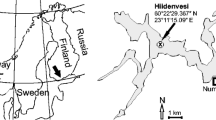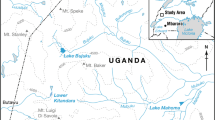Abstract
A multiproxy paleolimnological study of Douglas Lake, Michigan, was undertaken to elucidate the history of productivity and oxygen depletion in three basins of this multi-depression lake. Indicators investigated in three dated cores included chlorophyll a, Fe and Mn stratigraphy, and fossil chironomid assemblages. The coring sites were chosen to correspond to modern studies of oxygen depletion rates, and to determine if conclusions reached in these studies were supported by paleolimnological evidence. Stratigraphies of chlorophyll a, Fe and Mn indicate that two of the basins, South Fishtail Bay and Fairy Island, have been eutrophic and anoxic for a long period of time, predating European settlement. The third basin, Grapevine Point, has been consistently less productive, and had less severe oxygen depletion. Results of the chironomid analysis agree with these conclusions, including a change from mesotrophic to eutrophic indicator taxa in the Grapevine Point basin. All three cores show evidence of increasing trophic state in the most recent sediments, supporting some of the conclusions reached in the modern studies. It is also demonstrated that deforestation of the watershed had profound effects on littoral chironomid assemblages. Paleolimnological investigations also demonstrated the individual nature of the separate basins in Douglas Lake.
Similar content being viewed by others
References
Andresen, N. A., 1976. Recent diatoms from Douglas Lake, Cheboygan County, Michigan. Ph.D. dissertation, University of Michigan, Ann Arbor, Michigan.
Bazin, M. & G. W. Saunders, 1971. The hypolimnetic oxygen deficit as an index of eutrophication in Douglas Lake, Michigan. Mich. Acad. 3: 91–106.
Bennett, K. D., 1997. 'psimpoll' version 2.30: C program for plotting pollen diagrams and analyzing pollen data. Software.
Binford, M. W., 1990. Calculation and uncertainty analysis of 210Pb dates for PIRLA project lake sediment cores. J. Paleolim. 3: 253–267.
Binford M. W., J. S. Kahl & S. A. Norton, 1993. Interpretation of 210Pb profiles and verification of the CRS dating model in PIRLA project lake sediment cores. J. Paleolim. 9: 275–296.
Bosch, N. C. & J. D. Hewlett, 1982. A review of catchment experiments to determine the effect of vegetation changes on water yield and evapotranspiration. J. Hydrol. 55: 3–23.
Boucherle, M. M., J. P. Smol, T. C. Oliver, S. R. Brown & R. McNeely, 1986. Limnological consequences of the decline in hemlock 4800 years ago in three Southern Ontario lakes. Hydrobiologia 143: 217–225.
Brodin, Y., 1982. Palaeoecological studies of the recent development of Lake Växjöjön. IV. Interpretation of the eutrophication process through the analysis of subfossil chironomids. Arch. Hydrobiol. 93: 313–326.
Campbell, R. S., 1941. Vertical distribution of the plankton Rotifera in Douglas Lake, Michigan, with special reference to submerged depression individuality. Ecol. Monogr. 11: 1–19.
Coffman, W. P. & L. C. Ferrington, 1984. Chironomidae. In Merritt, R. W. & K. W. Cummins (eds), An Introduction to the Aquatic Insects. 2nd edn. Kendall/Hunt Publishing Co., Dubuque, Iowa: 551–652.
Davis, M. B., 1976. Erosion rates and land-use history in southern Michigan. Environ. Conserv. 3: 139–148.
Davis, M. B. & M. S. Ford, 1982. Sediment focusing in Mirror Lake, New Hampshire. Limnol. Oceanogr. 27: 137–150.
Dean, W. E., 1974. Determination of carbonate and organic matter in calcareous sediments and sedimentary rocks by loss on ignition: comparison with other methods. J. Sed. Petrol. 44: 242–248.
Eggleton, F. E., 1931. A limnological study of the profundal bottom fauna of certain fresh-water lakes. Ecol. Monogr. 1: 231–332.
Engstrom, D. R. & H. E. Wright, 1984. Chemical stratigraphy of lake sediments as a record of environmental change. In Haworth, E. Y. & J. W. G. Lund (eds), Lake Sediments and Environmental History. University of Minnesota Press, Minneapolis: 11–67.
Engstrom, D. R., E. B. Swain & J. C. Kingston, 1985. A palaeolimnological record of human disturbance from Harvey's Lake, Vermont: geochemistry, pigments, and diatoms. Freshwat. Biol. 15: 261–288.
Epler, J. H., 1992. Identification manual for the larval Chironomidae (Diptera) of Florida. Florida Department of Environmental Regulation, Tallahassee.
Fægri, K. & J. Iversen, 1975. Textbook of Pollen Analysis. 3rd. edn. Hafner Press, New York.
Francis, D. R., 1997. Bryozoan statoblasts in the recent sediments of Douglas Lake, Michigan. J. Paleolim. 17: 255–261.
Fritz, S. C., J. C. Kingston & D. R. Engstrom, 1993. Quantitative trophic reconstruction from sedimentary diatom assemblages: a cautionary tale. Freshwat. Biol. 30: 1–23.
Gaillard, M. J., J. A. Dearing, F. El-Daoushy, M. Enell & H. Hakansson, 1991. A late Holocene record of land-use history, soil erosion, lake trophy and lake-level fluctuations at Bjäresjösjön (South Sweden). J. Paleolim. 6: 51–81.
Gannon, J. E., 1971. Two counting cells for the enumeration of zooplankton micro-crustacea. Trans. Am. Micros. Soc. 90: 486–490.
Gannon, J. E. & D. C. Brubaker, 1969. Sub-surface circulation in South Fishtail Bay, Douglas Lake, Cheboygan County, Michigan. Mich. Acad. 2: 19–35.
Gates, F. C., 1912. The vegetation of the region in the vicinity of Douglas Lake, Cheboygan County, Michigan, 1911. Rep. Mich. Acad. Sci. 14: 46–106.
Gleason, H. A. & F. T. McFarland, 1914. The introduced vegetation in the vicinity of Douglas Lake, Michigan. Bull. Torr. Bot. Club 41: 511–521.
Hall, R. I. & J. P. Smol, 1993. The influence of catchment size on lake trophic status during the hemlock decline and recovery (4800 to 3500 BP) in southern Ontario lakes. Hydrobiologia 269/270: 371–390.
Kada, J. & M. Heit, 1993. 210Pb and 137Cs as indicators of sediment focussing of anthropogenic trace elements in lake sediments. Verh. Int. Verein. Limnol. 25: 256.
Kansanen, P. H., 1985. Assessment of pollution history from recent sediments in Lake Vanajavesi, southern Finland. II. Changes in the Chironomidae, Chaoboridae and Ceratopogonidae (Diptera) fauna. Ann. Zool. Fennici 22: 57–90.
Kansanen, P. H., J. Aho & L. Paasivirta, 1984. Testing the benthic lake type concept based on chironomid associations in some Finnish lakes using multivariate statistical methods. Ann. Zool. Fennici 21: 55–76.
Kilburn, P. D., 1957. Historical development and structure of the jack pine and oak vegetation types on sandy soils in northern lower Michigan. Ph.D. dissertation, University of Michigan, Ann Arbor, Michigan.
Kowalyk, H. E., 1985. The larval cephalic setae in the Tanypodinae (Diptera: Chironomidae) and their importance in generic determinations. Can. Ent. 117: 67–106.
Lawrenz, R. W., 1975. The developmental paleoecology of Green Lake, Antrim County, Michigan. M.S. Thesis, Central Michigan University, Mount Pleasant, Michigan.
Leavitt, P. R., 1993. A review of factors that regulate carotenoid and chlorophyll deposition and fossil pigment abundance. J. Paleolim. 9: 109–127.
Leavitt, P. R., S. R. Carpenter & J. F. Kitchell, 1989. Wholelake experiments: the annual record of fossil pigments and zooplankton. Limnol. Oceanogr. 34: 700–717.
Likens, G. E., F. H. Bormann, N. M. Johnson, D. W. Fisher & R. S. Pierce, 1970. Effects of forest cutting and herbicide treatment on nutrient budgets in the Hubbard Brook watershed-ecosystem. Ecol. Monogr. 40: 23–47.
Lind, O. T., 1978. Interdepression differences in the hypolimnetic areal relative oxygen deficits of Douglas Lake, Michigan. Verh. Int.. Verein. Limnol. 20: 2689–2696.
Lind, O. T., 1987. Spatial and temporal variation in hypolimnetic oxygen deficits of a multidepression lake. Limnol. Oceanogr. 32: 740–744.
Lind, O. T. & L. Dávalos-Lind, 1993. Detecting the increased eutrophication rate of Douglas Lake, Michigan: the relative areal hypolimnetic oxygen deficit method. Lake Res. Manage. 8: 67–71.
Mackereth, F. J. H., 1966. Some chemical observations on postglacial lake sediments. Phil. Trans. Roy. Soc. London B. 250: 165–213.
Meriläinen, J. J. & V. Hamina, 1993. Recent environmental history of a large, originally oligotrophic lake in Finland: a palaeolimnological study of chironomid remains. J. Paleolim. 9: 129–140.
Murchie, S. L., 1985. 210Pb dating and the recent geologic history of Crystal Bay, Lake Minnetonka, Minnesota. Limnol. Oceanogr. 30: 1154–1170.
Oldfield, F. & P. G. Appleby, 1984. Empirical testing of 210Pb-dating models for lake sediments. In Haworth, E. Y. & J. W. G. Lund(eds), Lake Sediments and Environmental History. University of Minnesota Press, Minneapolis: 93–124.
Oliver, D. R. & M. E. Roussel, 1983. The insects and arachnids of Canada, Part 11: The genera of larval midges of Canada. Publication 1746, Agriculture Canada. Ottawa, Ontario.
Patric, J. H., 1974. River flow increases in central New England after the hurricane of 1938. J. Forest. 72: 21–25.
Quinlan, R., J. P. Smol & R. I. Hall, 1998. Quantitative inferences of past hypolimnetic anoxia in south-central Ontario using fossil midges (Diptera: Chironomidae). Can. J. Fish. Aquat. Sci. 55: 587–596.
Robbins, J. A., 1978. Geochemical and geophysical applications of radioactive lead. In Nriagu, J. O. (ed.), The Biogeochemistry of Lead in the Environment. Elsevier/North Holland Biomedical Press, Amsterdam: 285–393.
Robbins, J. A., A. Mudroch & B. G. Oliver, 1990. Transport and storage of 137Cs and 210Pb in sediments of Lake St. Clair. Can. J. Fish. Aquat. Sci. 47: 572–587.
Sæther, O. A., 1979. Chironomid communities as water quality indicators. Holarctic Ecol. 2: 65–74.
Spurr, S. H. & J. H. Zumberge, 1956. Late Pleistocene features of Cheboygan and Emmet Counties, Michigan. Am. J. Sci. 254: 96–109.
Stahl, J. B., 1959. The developmental history of the chironomid and Chaoborus faunas of Myers Lake. Invest. Ind. Lakes Streams. 5: 47–102.
Stoermer, E. F., 1977. Post-Pleistocene diatom succession in Douglas Lake, Michigan. J. Phycol. 13: 73–80.
Strickland, J. D. H. & T. R. Parsons, 1968. A practical handbook of sea water analysis. Fish. Res. Bd. Can. Bull. 167.
Swain, E. B., 1985. Measurement and interpretation of sedimentary pigments. Freshwat. Biol. 15: 53–75.
Swank, W. T., L. W. Swift Jr. & J. E. Douglass, 1988. Streamflow changes associated with forest cutting, species conversions, and natural disturbances. In Swank, W. T. & D. A. Crossley (eds), Forest Hydrology and Ecology at Coweeta. Ecological Studies 66. Springer-Verlag, New York, 297–312.
Walker, I. R., 1987. Chironomidae (Diptera) in paleoecology. Quat. Sci. Rev. 6: 29–40.
Walker, I. R., E. D. Reavie, S. Palmer & R. N. Nordin, 1993. A palaeoenvironmental assessment of human impact on Wood Lake, Okanagan Valley, British Columbia, Canada. Quat. Int. 20: 51–70.
Wang, K. & R. J. Cornett, 1993, Distribution coefficients of 210Pb and 210Po in laboratory and natural aquatic systems. J. Paleolim. 9: 179–188.
Welch, P. S., 1927. Limnological investigations on northern Michigan lakes. I. Physical-chemical studies on Douglas Lake. Pap. Mich. Acad. Sci. Arts Lett. 8: 421–451.
Welch, P. S., 1944. More data on depression individuality in Douglas Lake, Michigan. Pap. Mich. Acad. Sci. Arts Lett. 30: 379–390.
Welch, P. S. & F. E. Eggleton, 1932. Limnological investigations on northern lakes. II. A further study of depression individuality in Douglas Lake. Pap. Mich. Acad. Sci. Arts Lett. 15: 491–508.
Whitehead, D. R., H. Rochester, S. W. Rissing, C. B. Douglass & M. C. Sheehan, 1973. Late glacial and postglacial productivity changes in a New England pond. Science 181: 744–747.
Wiederholm, T. (ed.), 1983. Chironomidae of the Holarctic region, keys and diagnoses. Part 1. Larvae. Ent. Scand. Suppl. No. 19.
Author information
Authors and Affiliations
Rights and permissions
About this article
Cite this article
Francis, D.R. A record of hypolimnetic oxygen conditions in a temperate multi-depression lake from chemical evidence and chronomid remains. Journal of Paleolimnology 25, 351–365 (2001). https://doi.org/10.1023/A:1011152709997
Issue Date:
DOI: https://doi.org/10.1023/A:1011152709997




